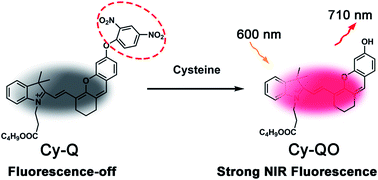A turn-on near-infrared fluorescent probe for detection of cysteine over glutathione and homocysteine in vivo†
Abstract
Cysteine (Cys) has emerged as a significant sensing target in recent years. Although a lot of biothiol probes have been developed and applied to cellular imaging through thiol-induced disulfide cleavage or Michael addition reactions, relatively few probes assessing Cys with high selectivity over glutathione (GSH) and homocysteine (Hcy) with near-infrared (NIR) fluorescence are capable of in vivo fluorescence imaging in biological systems. Herein, a NIR fluorescent turn-on probe for Cys monitoring in vivo was designed and synthesized. This probe demonstrated a rapid, tremendously selective detection process for Cys with remarkable NIR fluorescence enhancement (Ex: 600 nm, Em: 712 nm, ∼20 fold). In addition, this probe could be utilized to quantitatively detect Cys with a detection limit of 82 nM over a wide linear range (0.01–160 μM), fast response time (5 min) and low toxicity. Moreover, it was further demonstrated that this NIR fluorescent probe could be applied to detect Cys in living cells including L02, A549 and MCF-7 cell lines and different mouse models (tumor-bearing mouse model, hepatitis model and inflammatory model), revealing that this probe possesses great promise for further biological applications.

- This article is part of the themed collection: Analytical Methods Recent HOT articles


 Please wait while we load your content...
Please wait while we load your content...